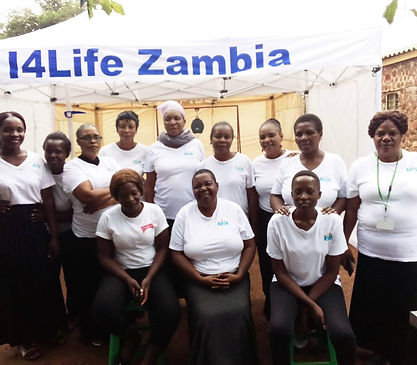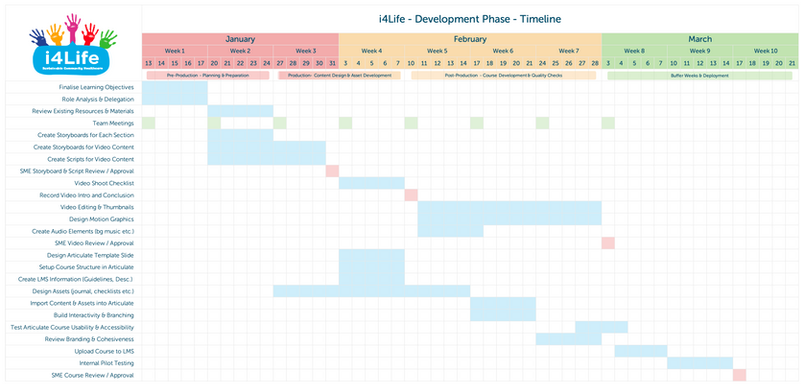
i4Life Pre-Departure
Training
This interactive training course combines scenario-based learning, gamification, and real-world knowledge and insights into a concise experience, ensuring volunteers are not only aware but also actively prepared to engage respectfully and effectively with local communities.
Project Overview
A collaborative course developed for i4Life, preparing Irish volunteers for placements in Zambia. The training addressed cultural orientation, practical preparation, and policies.
Audience
The training was developed for Irish volunteers preparing to travel to Zambia with i4Life, a medical charity that provides support for children living with HIV. Volunteers came from a range of backgrounds and had varying levels of previous travel or healthcare experience.
Responsibilities
This was a team-based university project in partnership with i4Life.
While collaborating closely with teammates and the client, I took the lead in:
-
Designing the overall visual and instructional layout of the course
-
Creating all content and interactions for Section 5: Policies & Procedures
-
Developing a drag-and-drop activity to help learners prepare and pack for travel
-
Formatting policies and procedures into an engaging learning module in Articulate Storyline
Tools Used:
-
Articulate Storyline (Main course development)
-
Adobe Illustrator and Blender (Icons and illustrations)
-
Adobe Premiere Pro and After Effects (Video editing)
-
Miro and Figma (mood board and prototyping)
-
Amazon Web Services Platform (Hosting Platform)

The Problem
Volunteers preparing for travel to Zambia were often overwhelmed by cultural, procedural, and medical requirements. Information was previously delivered through live sessions or PDFs, which weren’t always retained or accessible during travel.
i4Life needed a flexible, user-friendly solution that could provide consistent information and build confidence in volunteer readiness.
The Solution
Our team developed an interactive eLearning course that could be accessed prior to departure and reviewed anytime during travel. The course was broken into five sections, each addressing a key aspect of volunteer preparation, such as cultural sensitivity, medical safety, and personal conduct.
My contribution, Section 5, focused on:
-
Communicating essential policies (e.g., code of conduct, child safety) in a clear, digestible format
-
Using interactive design to improve engagement and knowledge retention
-
Simulating real-world decisions (e.g., what to pack) through a gamified learning activity

The Process - The ADDIE Model
The ADDIE (Analysis, Design, Development, Implementation, and Evaluation) model guided the development of the i4Life Pre-Departure Training, ensuring a structured and learner-centred approach:
Analysis
-
Interviewed the Founder of i4Life (SME) to identify learner needs, organisational goals, and critical content areas for inclusion in the Pre-Departure Training.
-
Reviewed existing Pre-Departure training materials from similar volunteer organisations to identify best practices, gaps, and opportunities for improvement.
-
Created a low-fidelity prototype in Figma to map the course structure, navigation, and flow, enabling early feedback and alignment with stakeholder expectations.
-
Defined clear, measurable learning objectives for each module, including the Policies & Procedures section (my contribution), to ensure alignment with Bloom’s Taxonomy and overall program goals.
Design
-
Worked as a team to create a comprehensive storyboard for the entire course, mapping out the sequence of modules, interactive activities, and informative pages to ensure a logical flow and consistent learner experience.
-
Collaboratively delegated section development among team members, assigning responsibilities based on strengths and ensuring each module aligned with the overarching learning objectives and instructional design approach.
-
Began producing course assets and training materials, including graphics, interactive templates, and instructional content, to support a cohesive design and smooth transition into development.
Development
-
Designed the overall look and feel of the entire course, establishing a cohesive visual style, navigation structure, and brand alignment across all sections.
-
Created the content for the Introduction, Section 5, and the Conclusion, ensuring consistency with the instructional goals and flow of the full course.
-
Built Section 5: Policies & Procedures in Articulate Storyline, featuring a drag-and-drop packing activity to simulate decision-making for travel preparation.
-
Chunked lengthy policy documents into concise, interactive elements (click-to-reveal tabs, scenario prompts) to improve learner engagement and comprehension.
-
Applied a warm, culturally respectful style aligned with i4Life’s values to promote inclusivity and learner connection.
Implementation
-
Compiled all team members’ sections into a single Articulate Storyline file, ensuring seamless integration while maintaining brand consistency, and intuitive navigation across the entire course.
-
Conducted internal peer reviews to verify smooth course flow, consistent visuals, and accurate content, addressing any gaps or inconsistencies before final delivery.
-
Prepared and delivered the complete course package to i4Life for deployment, enabling volunteers to access a fully cohesive, user-friendly learning experience.
Mood Board & Style Guide
When shaping the course visuals, I wanted the design to feel as welcoming and reassuring as i4Life itself. Working with the organisation’s brand guidelines, I leaned into their warm colour palette and approachable style to create an atmosphere of comfort and trust.
I built custom assets in Adobe Illustrator and integrated them in Articulate Storyline, keeping everything consistent across the modules so learners could focus on the content without distraction.

Key Features
-
Modular Design: Six clearly structured sections that users could explore at their own pace
-
Interactive Game: A custom drag-and-drop activity that reinforced practical decision-making
-
Content Simplification: Condensed complex policy language into learner-friendly, scannable content
-
Branded Aesthetic: Consistent visual identity across the course in line with i4Life’s values and tone Team
-
Collaboration: Designed shared templates and visual elements to ensure cohesion across team-developed sections

What I Learned
-
Leading visual design and contributing to UX decisions improved usability and team efficiency
-
Converting heavy procedural content into meaningful interactions is key to learner motivation
-
Clear documentation and layout standards helped the team maintain quality across all sections


Future Goals
This course could be expanded to include
mobile-first enhancements and offline access options for use in low-connectivity areas.
I would also like to integrate real-time feedback features, such as pre-trip checklists and follow-up quizzes, to help i4Life track volunteer readiness and gather learner data.























